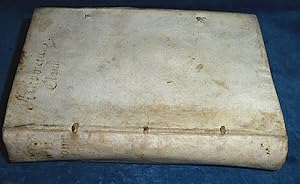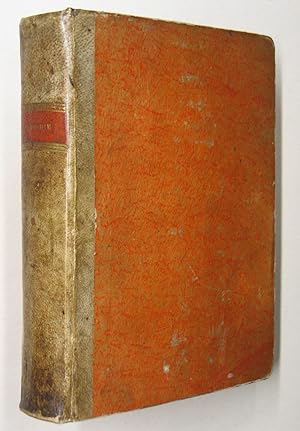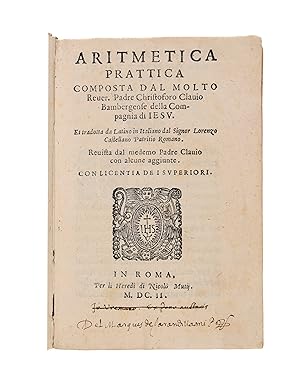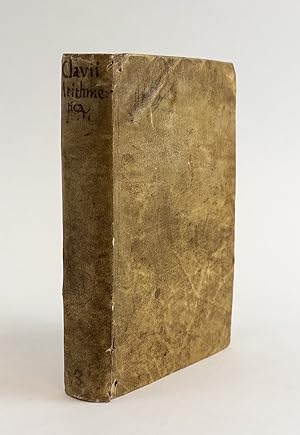Clavius Christopher ; (7 results)
Product Type
- All Product Types
- Books (7)
- Magazines & Periodicals
- Comics
- Sheet Music
- Art, Prints & Posters
- Photographs
- Maps
-
Manuscripts &
Paper Collectibles
Condition
Binding
Collectible Attributes
- First Edition
- Signed
- Dust Jacket
- Seller-Supplied Images (4)
- Not Printed On Demand (6)
Seller Location
Seller Rating
-
Christophori Clauii Bamb (Classic Reprint)
Published by Forgotten Books, 2024
ISBN 10: 1390392295ISBN 13: 9781390392296
Seller: Forgotten Books, London, United Kingdom
Book Print on Demand
Paperback. Condition: New. Print on Demand. Excerpt from Christophori Clauii Bamb. Ex Societate Iesu, in Sphæram Ioannis De Sacro Bosco, Commentarius. About the Publisher, Forgotten Books publishes hundreds of thousands of rare and classic books. This book is a reproduction of an important historical work. Forgotten Books uses state-of-the-art technology to digitally reconstruct the work, preserving the original format whilst repairing imperfections present in the aged copy. In rare cases, an imperfection in the original, such as a blemish or missing page, may be replicated in our edition. We do, however, repair the vast majority of imperfections successfully; any imperfections that remain are intentionally left to preserve the state of such historical works. This text has been digitally restored from a historical edition. Some errors may persist, however we consider it worth publishing due to the work's historical value. The digital edition of all books may be viewed on our website before purchase. print-on-demand item.
-
EPITOME ARITHMETICAE PRACTICAE nunc quinto ab ipso auctore anno 1606 recognita & multis in locis locupletata.
Published by publ. Bernard Walther, printed by Joannes Volmari., Moguntiae (Mainz), 1614
Seller: Abbey Antiquarian Books, Blockley, GLOS, United Kingdom
Condition: Good. Printers mark on title page, graphs & formulae in text. Duodecimo (155x95mm), contemporary laced vellum covers (lacks fastening straps), spine & front cover with faded MS title & author's name, ownership note on pastedown from library of Augustinian Canons of Herzogenburg (Austria), dated December 1, 1617 with initials of monk who bought it, 340pp +[11]pp index, collated complete. Titlepage & next few pages stained, small marginal worm holes pp69-115, lightly browned with some water stains throughout. *Epitome of practical arithmetic, reviewed & supplemented in 1606 by author himself. First published Rome 1583, last printed London 1631. Clavius was an early proponent of the Gregorian Calendar, and one of most respected astronomers & mathmeticians in Europe. 1 volume. Hardcover.
-
The Arenarius of Archimedes, translated from the Greek, with notes and illustrations; to which is added the dissertation of Christopher Clavius on the same subject, from the Latin
Published by London: J. Johnson; Oxford: Prince and Cooke, 1784
Seller: Moroccobound Fine Books, IOBA, Lewis Center, OH, U.S.A.
Association Member: IOBA
Book
Hardcover. Condition: Very Good. Translated by George Anderson. (4), xvi, 63 pp. with folding plate. Hardcover, bound in full calf, rebacked. Modest worming to the preliminary leaves; early ink notation at the bottom margin of xv, else the text unmarked. [Bas-C8-S2].
-
Houzeau - L. I, 2678 - De Backer-S. II, 1212,1 - vgl. Honeyman 708 (Ausg. 1581).- Fünfte römische Auflage; erweiterter bedeutender Kommentar über die Sternkunde des Johann de Sacrobosco.- Der deutsche Mathematiker und Astronom Christoph Klau (1537 - 1612), geboren in Bamberg, unterrichtete Mathematik am Jesuitenkollegium in Rom.- Titel mit gelöscht. hs. Besitzvermerk, leicht gebräunt u.tls. etw. fleckig, die ersten beiden Bll. mit kl. hinterlegt. Eckabriss, Ebd. etw. fleckig u. berieben.# With woodcut on title, woodcut illustrations and diagrams in text, half vellum of the 18 century with spine label. Houzeau - L. I, 2678 - De Backer-S. II, 1212,1 - see Honeyman 708 (Ausg. 1581).- Fifth Roman edition (first published in Rome 1581) of the most principal astronomical commentary on the astronomy of "De Sphera".- Clavius (1538-1612), a member of the Jesuit order, was one of the most respected astronomers in Europe. He was the main architect of the Gregorian calendar (which we use today), and his astronomical textbooks were widely used for over fifty years. His commentary on the "Sphaera" of Sacrobosco, first published in 1570, demonstrates his adherence to the geocentric model of the universe.- Title with deleted ownership entrie, lightly browned and slightly stained in part, the first two leaves with small loss of edge (deposited), binding slightly stained and rubbed. Il matematico bavarese Christopher Clavius (1538-1612), autore di un'enormità di opere, fu devoto difensore dell'ipotesi tolemaica dell'universo, ma lavorò duramente per difendere e illustrare la riforma.
-
EUCLIDIS ELEMENTORUM Accessit liber XVI. De solidorum regularium cuiusliber intra quodliber comparatione. Omnes perspicuis demonstrationibus.
Published by Alvise Zannetto, Roma, 1603
Seller: Accademia degli Erranti di Vada Monica, Torino, Italy
Opera in 2 volumi di cm 11X16 legati in mezza pelle, sguardie, frontespizio del primo volume, 62 cc. non numerate, bianca, 940 pp., colophon con registro; frontespizio del secondo volume (Euclidis posteriores libri IX. Accessit liber XVI de solidorum regularium.) restaurato da una mancanza dovuta ad antica macchia d'inchiostro che aveva bucato la carta, 925 pp., al verso dell'ultima colophon e registro, una carta d'errata. Importante, preclara edizione dell'opera del Clavio sulla geometria euclidea. Troppo nota l'opera, universalmente conosciuto l'Autore detto l'Euclide del XVI secolo. Ci si limita quindi ad una descrizione fisica dei volumi. Su carta ancor bianca e frusciante, il testo inquadrato in doppia cornice; poche e chiare arrossature su alcune pagine, contenute, ininfluenti mende d'uso, margine in alcuni quinterni corto, qualche volta sfiorante la prima delle due cornici. Ma esemplare in belle condizioni, raro, essenziale. Le opere matematiche dei classici sono tutte ricercatissime, e questa presentata ha una caratteristica abbastanza peculiare, il formato in 8 piccolo, quindi una sorte di tascabile. Eccezionale, completo, collazionato. Importante e raro.
-
Aritmetica Prattica. tradotta da Latino in Italiano dal Signor Lorenzo Castellano patritio Romano. Reuista dal medesimo padre Clauio con alcun e aggiunte. Rome, heirs of Nicolo Muzio, 1602
Publication Date: 1602
Seller: Maggs Bros. Ltd ABA, ILAB, PBFA, BA, London, United Kingdom
Woodcut Jesuit device to title-page, initials, tail-piece, and typographical decoration; tables and simple woodcut diagrams. 8vo (162 x 110mm). [16], 281, [15] pp. Contemporary Spanish? vellum over pasteboards, ink lettering on spine, ties. A fascinating copy with important Jesuit associations, being a gift from the author, the famous mathematician Christopher Clavius, to his student Ivan Vreman who would also become a gifted mathematician and a missionary in Macao. Christopher Clavius (1538-1612), a German Jesuit from Bamberg, taught mathematics at the Collegium Romanum for decades and published textbooks of great influence: his Euclid was translated into Chinese by Matteo Ricci and used in China. Epitome arithmeticae practicae had originally been composed for internal use in the Collegium and goes back to before 1580. The Latin text was published first in 1583 and it would seem that the translator Castellani, a pupil of Clavius, was intimately connected with it from the beginning as he had urged its publication to the wider world (see note in Baldini (2003) p. 71). The Italian translation of his textbook, intended to bring the work to an even wider readership, was published in 1586 in Rome. This is the second revised edition and is rare with copies located by OCLC in UK/USA only found at Cambridge, Brown, Columbia, and Duke. There were further editions, 1613, 1618, 1626 (Rome) with a number of Venetian editions up to 1738. Castellani explains that he has on occasion and for clarity slightly expanded the text. Various works by Clavius made their way to China and were translated into Chinese. In a letter to the Jesuit General Acquaviva dated 22 August 1608 Matteo Ricci writes that this little work on practical arithmetic has already been translated into Chinese and reached Beijing where they wish to print it. Ricci had already read and expounded it to Li Zhizao and in 1613 it was published with the title Tongwen suanzhi [Arithmetic Guidance in the Common Language], (M. Ricci, Lettere (1580-1609) ed. P. Corradini, F. D?Arelli etc., Macerata: Quodlibet, 2001, p. 491 and note 5); it was the first mathematical book to introduce Western written calculations into China. In an earlier letter to Clavius himself 25 December 1597 from Nanchang, ** Ricci speaks of Clavius? book on the astrolabe which he had received in 1596 ?molto bello ligato nella India? and which had caused quite a stir amongst men of learning (op.cit p. 352). **During the reign of the Wanli Emperor of the Ming dynasty, Nanchang housed relatives of the emperor who had been exiled because they were potential claimants of the imperial throne. They constituted a quarter of the city's population. For this reason, Matteo Ricci came here when trying to gain entry to Beijing. (Mary Laven, Mission to China: Matteo Ricci and the Jesuit Encounter with the East, 2011, p. 103). The translator Castellani was the author of Responsio ad expostulationem Francisci Vietae contra C. Clavium, Rome: Ziletti, 1603, a short tract of 18pp. (plus title leaf) reprinted with other works on the calendar at the end of volume 5 of the Mainz 1612 edition of Clavius Opera). Of this pamphlet there is a copy inscribed by Clavius (in the same hand as has inscribed this volume) to Philippus Fuester in Vienna (ONB 72.J.44(5)). Provenance: This copy is inscribed as a gift of the author Clavius to an identifiable pupil in Rome, a Croatian called Ivan Vreman or Ureman. Vreman was from Split and came to Rome in 1600 where in February 1600 he joined the Jesuits. A student at the Collegio Romano between 1602 and 1607, he was 1607/8 a member of Clavius? Academy of Mathematics along with fathers Giulio Aleni, a celebrated figure in China, and Lembo (Baldini p.74). He was also a keen astronomer as can be seen from correspondence with the Italian astronomer Giovanni Magini, in which he described his observation of a lunar eclispe on the night of January 19/20, 1609, together with his professors Clavius and Grienberger.Later in that year he departed for Lisbon, point of departure for China, but did not actually leave for the East until 1615. In 1614-15 he offered private tuition in mathematics in the college at Lisbon. In May 1615 he left for Goa and while on the journey he observed lunar eclipses, systematically measured and determined magnetic declinations, determined the differences between European and Asian time and the positions of places from Goa to Macau. A fragment of the letter containing his results was published by Athanasius Kircher in 1643. In 1616 arrived at Macau where he seems to have taught mathematics and other subjects until 1620/21 when he was sent into the interior of China in late 1619. Whilst there he also translated from Portuguese into Italian and Latin material for the Litterae annuae. Vreman, who had poor health in China, died at Nanchang 22 April 1620 but his body was taken 500 miles North to Nanjing for burial later. The volume is in a contemporary (probably Spanish) binding and has an early 17th century Spanish provenance of the Marqués of Jarandilla. This marquisate was created in March 1599 by Philip III of Spain. In 1619 the 6th count of Oropesa, Fernando Alvarez Toledo Portugal (1597-1621) received the title and became the first Marqués de Jarandilla. His father, Eduardo de Braganza (1569-1627) 1st Marquis of Frechilla and Villarramiel, had married Beatriz Alvarez de Toledo, heir to the count of Oropesa and her name was kept. As chance would have it, Vreman seems to have taught for a year or two at the college at Oropesa in the province of Toledo, when he was on his way to Lisbon. This Colegio de San Bernardo had been founded in 1578 by Francisco Álvarez de Toledo (1515-82) Viceroy of Peru 1569-1581, who gave a substantial sum for the foundation of the library there (see Kathleen M Comerford Jesuit Libraries, Leiden: Brill, 2022 p. 9). A little browned and foxed but generally fresh; some worming in blank space at bottom of last leaf. De Back.
-
CHRISTOPHORI CLAUII BAMBERGENSIS E SOCIETATE IESU EPITOME ARITHMETICAE PRACTICÆ
Published by Ex Typographia Dominici Basæ, Romae, 1585
Seller: Second Story Books, ABAA, Rockville, MD, U.S.A.
Hardcover. Octavo, 323 pages, [13]. In Very Good condition. Bound in full contemporary vellum, with ink titling to spine. Boards show mild shelf wear and rubbing to vellum. Text block has a small red ink name stamp to front free end page, a small bookseller ticket to front pastedown, and small scattered early marginalia. Title vignette (Jesuit device). Errata on page 323. Pages 202, 203, 206, and 207 mis-numbered 102, 103, 106, and 107, respectively, with pages 206 and 207 hand-corrected. Extremely scarce. SP Consignment. Shelved in Case 3. The foremost early figure in Jesuit science, Christopher Clavius (1538-1612) was one of the chief architects and defenders of the 1582 calendar reform under Pope Gregory XIII, leading to the modern Gregorian Calendar. Pope Sixtus V said: "Had the Jesuit order produced nothing more than this Clavius, on this account alone the order should be praised". His Euclid Elementorum (Rome, 1589) was brought by Matteo Ricci to China and translated into Chinese. In his Astrolabium (Rome, 1593) he uses a dot to separate whole numbers from decimal fractions and is arguably the first to do so. His Gnomonices (Rome, 1602) contains every then-known principle concerning the measurement of time. Galileo was a frequent visitor to the Jesuit Roman College, and he and Clavius corresponded frequently. 1343886. Shelved Dupont Bookstore.







